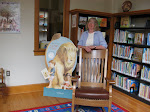Sometimes I think, reading a book about someone’s loss and grief is like poking my tongue in a cavity. I know it’s going to hurt, but I can’t stop myself from doing it. I think, reading about grief, is also reading about love. I want that vicarious experience of a love that makes loss so painful and poignant. And I also want the reassurance that loss can be survived. In her memoir, Let’s Take the Long Way Home, Gail Caldwell delivers all that and more. She tells the tale of her life changing friendship with fellow writer, Caroline Knapp. And then when Caroline dies of lung cancer at the age of 42, Caldwell takes us along on her journey through the barren land of grief.
Gail and Caroline were introduced by their dog trainer. Their friendship, based on a love of dogs, the writing life, and their shared history of alcoholism, was a once in a lifetime relationship that grounded and stretched them both. Grieving Caroline took Caldwell through territory for which she had no map. Caldwell writes, “The only education in grief that any of us ever gets is a crash course. Until Caroline died I had belonged to the other world, the place of innocence and linear expectations, were I thought grief was a simple, wrenching realm of sadness and longing that gradually receded. What that definition left out was the body blow that loss inflicts, as well as the temporary madness, and a range of less straight forward emotions shocking in their intensity.” (p. 150)
Let’s Take the Long Way Home is a moving story of two women’s friendship, but it’s more than that. Gail Caldwell’s story chronicles the struggle of two women to carve out their own lives. It tells of the power of the human-canine relationship and the way dogs draw people together. Most of all it tells of living through the desolate landscape of grief.
A few years ago, I read Joan Didion’s The Year of Magical Thinking, another moving memoir about loss. The book begins with Didion and her husband’s return from the hospital where their adult daughter was unconscious in the intensive care unit. As they sat at their dining room table that evening, Didion’s husband had a heart attack. He didn’t live to make it to the hospital. Didion writes of her year following his death, her year of grieving for her husband, while trying to cope with her daughter’s life threatening illness. The title comes from Didion’s realization that grief took her to a world where she wasn’t always sure what was real and what wasn’t, where she couldn’t always remember whether her husband was truly gone or not. Her writing is so intense, so deep, that reading it felt like I was experiencing the same confusion and uncertainity that Didion herself lived through. Didion’s magical thinking of grief comes alive with her very words.
Yet, friends and lovers aren’t the only things we grieve. Phillip Simmons’ book Learning to Fall tells the story of Simmon’s diagnosis with ALS, or Lou Gehrig’s disease. Simmons, a healthy young man with small children, faced the loss of his ability to walk, to carry his children, and finally to breathe on his own. He confronted losing the dream of a future, of watching his children grow up. And finally he grieved the loss of his own life, watching his days grow short as his body failed him. It’s a grief of a different order, told powerfully by a man who struggled to find joy and meaning in his diminishing days and body. Through loss, he wrote, he learned “the art of living.”
As I read Didion’s book, often crying, Bruce asked me why I was reading it. It’s hard to explain, how something so sad, can also be uplifting. Even though these books aren’t easy reads, they all left me hopeful. Life can be hard and painful, but grief somehow says we are alive, we loved well and we can learn the “art of living” as Simmons calls it. For a sad, yet hopeful read, pick up one of these books. But keep a box of tissues handy.
Subscribe to:
Post Comments (Atom)


Priscilla,
ReplyDeleteYes, we all need a good cry from time to time. Thank you for sharing some of your momentous cry books.